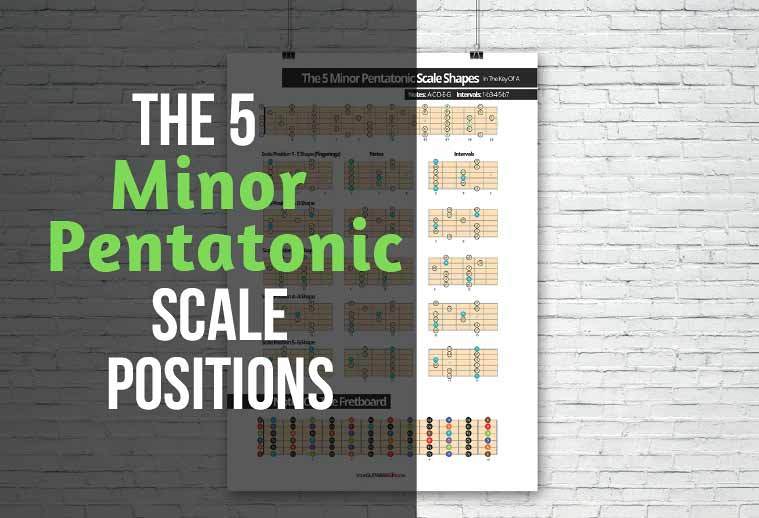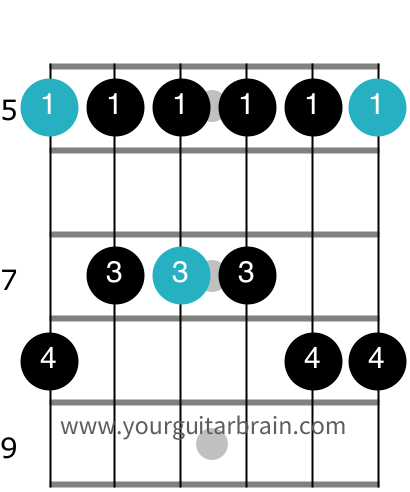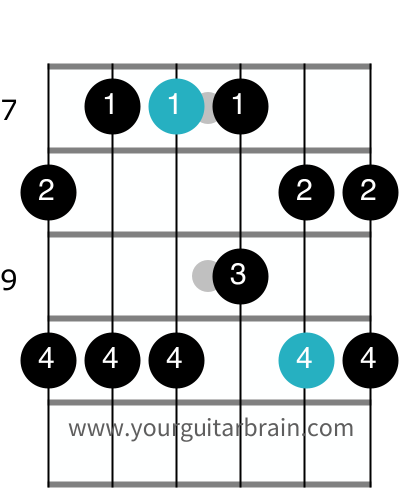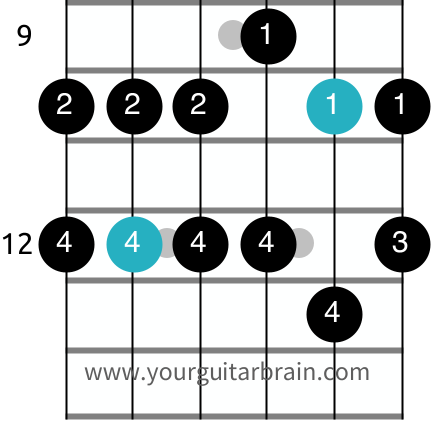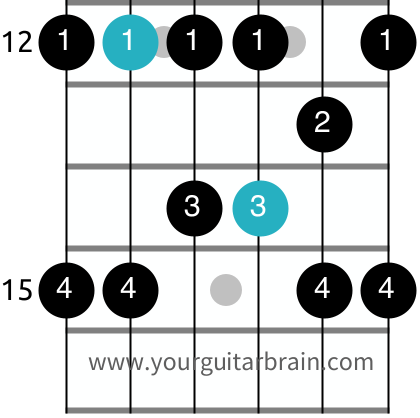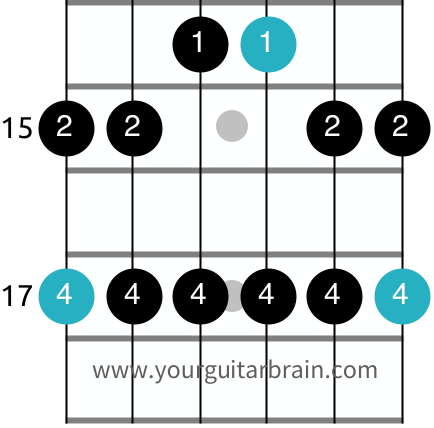Learn all five minor pentatonic scale shapes to help you start improvising and playing lead guitar.
In this beginner & intermediate guitar lesson, you will learn the guitar’s five minor pentatonic scale positions.
To help you turn the scales into music, you’ll find scale charts plus FREE A minor jam tracks for you to practice the patterns over.
We’re going to use the key of A as an example of this popular type of minor scale.
Table of Contents
What is a Movable Scale Shape?
The beauty of the five pentatonic scale shapes you’re about to learn is that they are movable.
A movable scale shape is a pattern of notes that can be moved around the fretboard to play the scale in any key. This is in contrast to a fixed scale shape, which is only playable in one key.
Movable scale shapes are a powerful tool for guitarists because they allow you to play the same scale in any key without having to learn a new fingering pattern.
This can be a huge time-saver, especially if you’re playing in a variety of keys.
That question answered; let’s kick things off by answering another common beginner guitar player question…
What is The Minor Pentatonic Scale?
The minor pentatonic scale is a 5 note scale that is the most popular scale to learn on guitar. This common minor scale sounds bluesy and is used in many styles of music to play lead guitar and improvise.
The pentatonic scale is also the perfect go to scale to add to your guitar practice routine whether you are a beginner, intermediate or advanced guitarist.
Finger speed, finger control plus your sense of timing and rhythm improve drastically when you practice scales.
The minor pentatonic scale is derived from the natural minor scale, whose scale interval formula and notes in the key of A are as follows:
Natural Minor Scale Interval formula:
1 – 2 – b3 – 4 – 5 – b6 -b7
Notes: A – B – C – D – E – F -G
Good to Know
Think of interval scale formulas as a kind of musical recipe that works for all 12 music keys. The only thing that changes is the ingredients, and those ingredients are chosen based on the first note (aka root).
Here is the formula for a minor pentatonic scale, which is identical to the natural minor scale, apart from the fact it leaves out the 2nd and ♭6th notes:
Minor Pentatonic Scale Interval formula:
1 – b3 – 4 – 5 -b7
Notes: A – C – D – E – G
4 Pentatonic Practice Tips
- Don’t dive head first trying to learn all 5 scale positions at once. Beginner players should tackle a scale position one at a time. Try to cram them all into a few practice sessions, and you ruin your chances of memorizing them.
- Remember, good technique should always be your key practice goal. See this article for some effective practice tips to help you improve fast and avoid wasting practice time.
- Always use a metronome on a slow, steady speed to start with. Gradually increase the speed as the scale shapes feel easier to play.
- Practice the five minor pentatonic positions to a backing track to spice it up and turn the scales into more than just an exercise: Minor pentatonic jam track.
Good to Know
When playing the following scale shapes, the numbers in the circles tell you which finger to play the note with: 1 = first (index), 2 = second (middle), 3 = third (ring), 4 = fourth (pinky).
The 5 Minor Pentatonic Shapes
Minor Pentatonic Scale Pattern 1
All of the five pentatonic scale positions are associated with a particular open chord shape.
This first minor pentatonic scale shape is based around the E major chord shape. It starts on the A root note played on the 5th fret of the low E string with your 1st finger.
Follow the practice tips below the scale chart to help you practice your best.
More Scale Practice Tips:
1 – Play the scale using alternate picking (downstrokes to upstrokes)
2 – Get comfortable playing the scale pattern forwards first, then play it backwards.
3 – Once you’ve memorised the shape use a metronome to develop solid timing. No speeding up and slowing down!
4 – Practice playing the scale over an A minor backing track.
Minor Pentatonic Scale Pattern 2
In this second minor pentatonic scale position, you move up a tone and a half from position one.
Starting on the C note, this position feels a little different because you start with your 2nd finger and then your pinky:
Focus on your ear training. Does minor pentatonic scale shape two sound any different to scale shape one?
To be able to properly answer this question, scroll down and play both scales over the backing track provided at the bottom of the page.
This minor pentatonic shape is based around the D major chord shape.
Minor Pentatonic Scale Pattern 3
In this third pentatonic scale position we start on the D note found on fret 10 of the 6th string.
Be sure to play the scale slowly remembering to focus on executing good playing technique, such as, alternate picking and playing with a metronome to improve your timing.
This scale shape is based around the C major chord shape.
Minor Pentatonic Scale Pattern 4
For box position number four, you start with you first finger on fret 12, followed by your pinky finger on fret 15.
This scale shape is based around the A major chord shape because the A root note is found on the 5th and 3rd strings in keeping with an open A major chord.
Minor Pentatonic Scale Pattern 5
The fifth and final minor pentatonic scale position in the key of A takes us up to the dusty end of the guitar fretboard.
Start with your 2nd finger on the G note and practice playing forwards only to start with.
The shape is based around the G major chord shape thanks to the placement of the root notes on the low E, G and top E strings.
Pro Tip
The 5th scale position on guitar can be tricky to play. But there's a shortcut! Simply drop the shape down to the lower octave and start with the G note on the 3rd fret of the low E string.
Limited-Time Offer! Save 15% on Essential Guitar Chord Digital Poster
Struggle to remember chord shapes? No more! Start learning to play the chords in your favourite songs fast without waiting for shipping ⇩
- Major (C, A, G, E, D, B, F)
- Minor (Cm, Am, Gm, Em, Dm, Bm, Fm)
- Seventh (C7, A7, G7, E7, D7, B7, F7)
- Major seventh (CMaj7, AMaj7, GMaj7, EMaj7, DMaj7, BMaj7, FMaj7)
- Minor seventh (Cm7, Am7, Gm7, Em7, Dm7, Bm7, Fm7)
- Easy open chords + full barre chords
- CAGED guitar chords
When Will I Be Ready to Turn Scales Into Music?
You will be ready to turn scales into music when you can play them fluently and comfortably.
You can only truly say you’ve learned a scale shape when:
- you have memorised the scale shapes off by heart
- you can play the scales cleanly at both slow and faster speeds
- you can play the notes consistently ascending and descending
- you can mix it up and play the notes in a random order
- you can transpose the scale into different keys
Of course, there is no one-size-fits-all answer to this question. The time it takes to be ready to turn scales into music will vary from person to person.
But if you practice regularly and stay patient, you will eventually reach a point where you feel comfortable and confident doing it.
A Minor Pentatonic Practice Backing Tracks
Because I know that playing with a metronome isn’t always the most exciting of things in the world, here are three practice jam tracks for you. All are in the key of A minor.
Bookmark this page and come back to practice with the backing track every day for 5-10 minutes to see how you’re progressing.
A Minor Pentatonic: Jam Track 1
This audio backing track is a 100bpm funky A minor vamp for you to practice the A minor pentatonic scale shapes over.
D Minor Pentatonic: Jam Track 2
This second acoustic guitar and drum D minor backing track at 80bpm.
Practice different rhythm values such as quarter (crotchet) notes and eighth (quaver) notes. When the scales start to feel easier to play try improvising some creative phrases instead of playing the scale simply ascending and backwards.
A Minor Pentatonic: Jam Track 3
This A minor backing track is played at 75bpm and features a crunchy tremolo electric guitar rhythm part over a drum groove.
The chords include Am – F Major – G Major and a surprise non-diatonic E major chord.
Can you name the other chords?
This track is 4 minutes long and playing your minor pentatonic scales is the perfect way to start off your guitar practice sessions.

